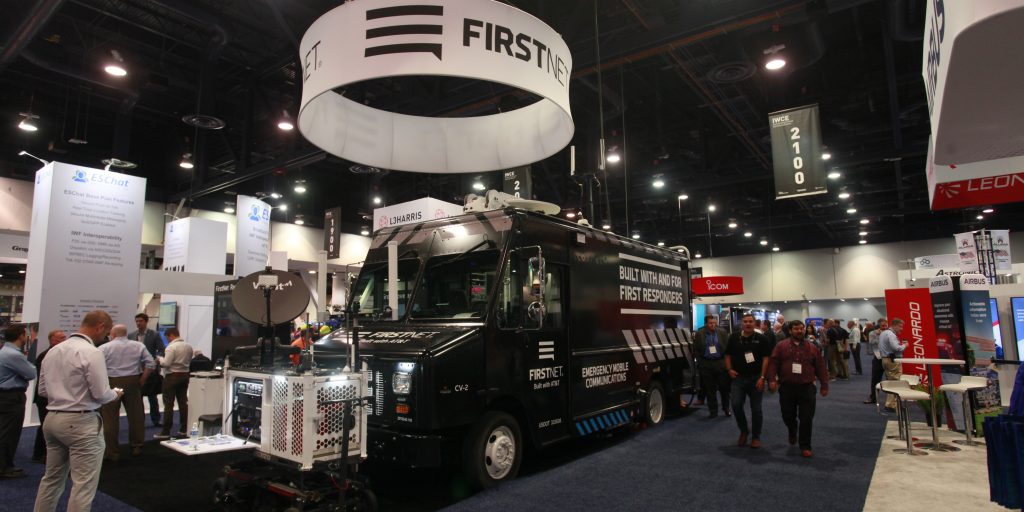IWCE 2022: Interoperability highlighted; ‘We are, in fact, stronger together’
The 2022 International Wireless Communications Expo (IWCE) at the Las Vegas Convention Center came to a close Thursday with a passionate call for collaboration, interoperability at a morning keynote address by Billy Bob Brown Jr., executive assistant director for emergency communications with the federal Cybersecurity and Infrastructure Security Agency.
“No doubt, all of you have been watching over the last several weeks the situation as it’s been unfolding in Europe, and in Ukraine,” Brown said, citing “Incredible international concerns that impact national security,” and in turn, “all of us here in the U.S.”
Faced with these generational challenges, Brown said he finds inspiration in “the words of the Declaration of Independence, and this document, the Constitution,” he continued, removing a copy from his pocket. Within it, he said, are guiding philosophies like “we are all created equal.”
Following in the footsteps of those who scribed the nation’s foundational documents, Brown continued, “We can come through this crisis of our generation if we work together.”
This theme of collaboration and interoperability was one repeated throughout the many sessions of the expo. IWCE is an annual trade show hosted by American City & County’s sister publication, IWCE’s Urgent Communications, and Omdia, which is owned by its parent company, Informa. The show started Monday and continued through Thursday, featuring cutting-edge communication technology and a more than 100 panel discussions, drone demonstrations and talks ranging from one titled “Unifying cyber and physical security for emergency communications centers” to “Today’s satellite: Different than you may remember.”
Another important theme highlighted by the show was the success of the public-private partnership of FirstNet, a national broadband network commissioned by Congress in 2012 exclusively for public safety communications. It’s been five years since the board decided to contract with AT&T, and more than 95 percent of the project has been completed—six months ahead of schedule. Given its sucess, with nearly 20,000 agencies signed on already, interoperability between disparate devices and services that work on the network is more important than ever.
That mission rings true beyond the telecommunication industry, too.
“Anything that divides us is a problem,” Brown said. “I’m a big believer that competition drives innovation, but competition unchecked divides. It creates that space that cyber actors (exploit). … In the current national security crisis we’re in, we cannot afford for that to be a part of our future.”
On a more technical level, interoperability was showcased prominently throughout the many vendor products on display at the expo’s more than 200 exhibitors. Drones, antennas, unbreakable radios, wireless technologies, software, service providers, robots, next-generation 9-1-1 interfaces—none of them can operate by themselves.
The trade show itself, which kicked off in-person Monday for the first time since news of the pandemic broke headlines two years ago, stood as a physical representation of just how important collaboration is within the mission critical telecommunications and public safety sector.
Supriya Sen, global services manager at Softil Innovative Communications, which provides enabling technologies for developers of IP-based communications like push-to-talk over broadband in the public safety industry, said it’s been a challenging few years across the industry. Sotil is a software-based product that “allows off-the-shelf products to communicate with emergency communications centers,” he explained, and because of that, remote sessions aren’t a great way showcase products to prospective clients.
“To have people actually touch and feel the devices, you can’t do that over Zoom,” Sen said, noting his company had been coming to the show for about three years before COVID-19 put a temporary pause on trade shows.
The show is a chance for vendors to interface with front-line public safety workers, pitching products and building relationships. Debs Watson, western regional sales manager for BTech, said they’ve been coming since around 2013 or so for the opportunity to “inform and educate” about their services.
Within a variety of environments including “utilities, substations, we monitor the health of batteries to make sure they’re at optimal performance,” Watson said. ”(Los Angeles) L.A. county, L.A. fire, we’ve got a lot of critical city, county infrastructure.”
Faced with unprecedented telecommunication threats and challenges—from wildfires to international state actors—Brown said it’s more important than ever to combine skillsets (through interoperability, among other means) and share information.
When this happens, he said. “I am confident that we can, as a generation, overcome this crisis if we work together. … We are in fact, stronger together.”




















